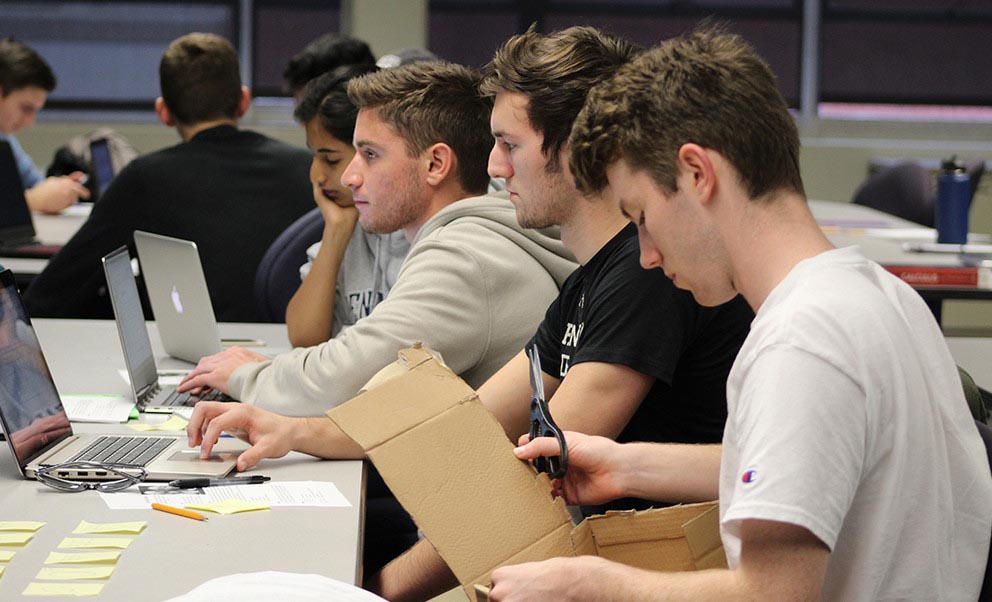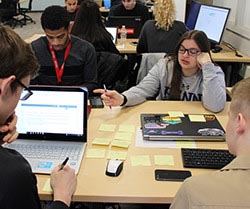
Students in a section of EDSGN 100: Cornerstone Engineering Design work on a design practicum that challenged them to design a lost dog locating device. Photo taken October 2017. IMAGE: PENN STATE
Hands-on education and evaluation equate to hands-on efficacy
Study finds practicums improve first-year engineering students’ design self-efficacy more effectively than written exams
3/4/2021
By Samantha Chavanic
UNIVERSITY PARK, Pa. — To navigate the evolving industry landscape, today’s engineers complement their technical breath, theoretical understanding and practical application abilities with professional proficiencies such as innovation, creativity and interpersonal skills. Many colleges and universities across the United States, including Penn State, have shifted their educational models to project-based learning approaches to better provide students with the real-world experiences needed for their future careers.
Researchers in Penn State’s College of Engineering applied this project-based learning (PBL) model to investigate how design practicums influence first-year engineering students’ engineering design self-efficacy or confidence in completing a specific design task. These practicums offer hands-on evaluations that mirror PBL experiences by tasking students with directly applying their design skills. The researchers published their results in the Journal of Mechanical Design online in November 2020, and the paper will be featured in the May print version of the journal.
“In SEDTAPP [School of Engineering Design, Technology, and Professional Programs], we have the privilege of teaching nearly every first-year student in the College of Engineering,” said paper author Chris McComb, James L. Henderson Jr. Memorial Assistant Professor and assistant professor in engineering design. “That’s a critical time for the development of their identity as an engineer, so I think we need to take every opportunity we can to boost their self-confidence — including during evaluations, like exams.”
To measure student design self-efficacy, researchers developed a traditional written exam and a design practicum for four EDSGN 100: Cornerstone Engineering Design sections. Designed to assess the core concepts taught in this first-year engineering course, the exam and practicum examined students’ understanding of the design process. The two-hour traditional exam consisted of multiple choice and short answer questions.
The exam questions asked students to apply engineering design concepts in various theoretical design capacities but did not provide students with a hands-on experience or specifically test their abilities to effectively communicate engineering concepts.
The design practicum consisted of an in-class design teaming experience and an individual out-of-class reflection on the project. This evaluation component allows students to critically reflect on their design skills and gives instructors an opportunity to more comprehensively assess students’ hands-on and communications abilities.
“Project-based learning (PBL) experiences help first-year students develop critical skills that they will need as they become successful engineers,” said first author Hannah Nolte, industrial engineering doctoral candidate. “PBL experiences allow students the opportunity to work in teams, develop critical thinking and communication skills and apply knowledge they’ve learned in class.”
Before and after the evaluations, students completed pre-assessment and post-assessment surveys to gauge their design self-efficacy. When evaluating the surveys of those students who took the traditional exam, researchers found no significant differences from pre- to post-assessment. Researchers did find an increase in design efficacy in those students who completed the design practicum. Women students that completed the practicum saw the largest increase in design self-efficacy.
“PBL projects more closely align with real-world engineering work, which can help students better understand what a career in engineering looks like,” Nolte said. “It is challenging to offer traditional exams that allow students to develop these skills. Often, traditional exams assess students’ abilities to memorize and recite what they have learned rather than assessing if they can truly apply what they have learned.”
McComb agreed, sharing his own experiences as an engineering student and his drive to improve his students’ learning experiences as his motivations behind the project.
“When I was an undergrad, and even when I was a grad student, I hated taking exams — when I was done, I always felt worse about the material than I did before the exam,” he said. “There’s no reason that needs to happen, as long as we can still assess learning. This project was all about addressing that part of the student experience. I want the evaluations in my classes to bring some joy to engineering.”
Other paper authors include Catherine Berdanier, Clyde W. Shuman Jr. and Nancy Shuman Early Career Assistant Professor and assistant professor of mechanical engineering, and Jessica Menold, Hartz Family Career Development Assistant Professor and assistant professor of engineering design and mechanical engineering.




